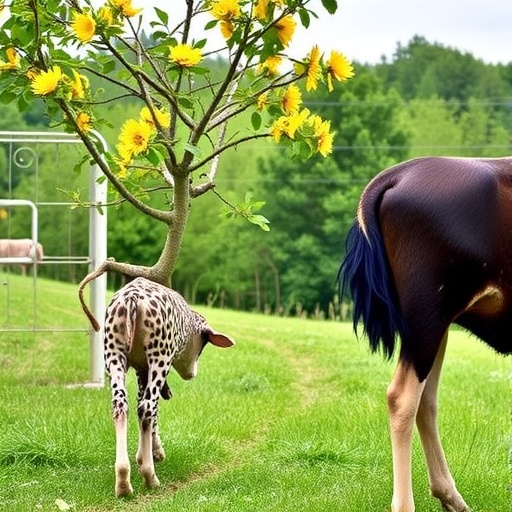A groundbreaking study led by researchers at the University of Oxford, in close collaboration with Dutch sustainable dairy coalition Duurzame Zuivelketen (DZK), has unveiled an innovative framework designed to help agricultural sectors worldwide meet global biodiversity targets effectively, while preventing unintended environmental consequences. Published on August 11, 2025, in the influential journal npj Biodiversity, this research scrutinizes the complex biodiversity impacts linked to the Dutch dairy industry and proposes novel safeguards that could transform how biodiversity goals are pursued across the agricultural landscape.
The investigation hinged on comprehensive 2020 data encompassing nearly 8,950 Dutch dairy farms, encompassing approximately 1.6 million cattle. Central to the study was the development of a unified biodiversity impact score that aggregates diverse environmental drivers—including greenhouse gas emissions, land conversion, and ammonia release—into a single composite indicator. This metric translates various pressures into a standardized measure reflecting the proportion of species facing extinction risk in affected regions, providing a powerful lens to gauge agricultural impacts on biodiversity.
However, the researchers caution against an overreliance on such aggregate scores. While they prove invaluable for monitoring broad trends and sector-wide biodiversity footprint reductions, these simplified indices can obscure critical local effects, such as nutrient loading or habitat fragmentation, which existing metrics insufficiently capture. The team argues that this masking effect risks allowing environmental trade-offs where mitigating one impact inadvertently exacerbates another, undermining overall biodiversity objectives.
To navigate this intricate puzzle, the Oxford-led consortium devised a suite of scientifically grounded safeguards. These safeguards establish clear, quantitative thresholds designed to block the transfer of harm from one environmental domain to another. They encompass two principal categories: impact prevention measures and impact compensation protocols. Prevention safeguards set binding limits on factors such as imported feed volume, nitrogen and ammonia emissions, and the preservation of grasslands and biodiversity-rich habitats. Compensation safeguards specify conditions under which unavoidable damages must be offset by prompt, sustained restoration of equivalent ecosystems within the same biogeographical context.
This multifaceted approach emerged from an extensive engagement with Dutch dairy stakeholders—including industry representatives and conservation groups—ensuring the framework’s relevance to national policies and international biodiversity commitments articulated in the Global Biodiversity Framework. The collaboration reflects a forward-looking model for integrating science, policy, and practice in pursuit of sustainable agriculture.
A striking revelation of the analysis was the disproportionate biodiversity loss occurring beyond Dutch borders. Much of the harm traced back to imported feed ingredients, whose production involves land conversion and habitat loss overseas. This externalized impact underscores the global connectivity of agricultural supply chains and the necessity of incorporating imported resource footprints into sustainability assessments. Conversely, nutrient pollution within the Netherlands, though politically and environmentally prominent, was found to contribute relatively modestly to global biodiversity decline, illustrating the nuanced spatial scales at which different environmental pressures operate.
The study further lays out three pragmatic transition pathways for the dairy sector. These range from an adaptive compensation-heavy route relying largely on offsetting harm post-occurrence, to a deep net positive trajectory centered predominantly on preventing biodiversity loss upfront. Each pathway embodies strategic trade-offs among production intensity, land utilization, and restoration capacity, highlighting the need for careful balancing to realize nature-positive futures without severely compromising agricultural output.
Associate Professor Joseph Bull, the lead author, emphasized the importance of nuanced biodiversity indicators, stating that “while aggregated impact scores are extremely useful, they can mislead if used in isolation. Our introduction of safeguards ensures that improvements in one area don’t cause collateral damage elsewhere.” Dr. Joseph Poore, co-author, added that advances in biodiversity measurement will soon empower consumers and businesses with unprecedented transparency regarding the biodiversity footprints of products, thus catalyzing market-driven improvements.
From a technical standpoint, the composite biodiversity index employed integrates multiple environmental pressures based on their relative contribution to species extinction risks, leveraging state-of-the-art ecological modeling and spatial analysis. This affords a more holistic understanding of the multifaceted impacts stemming from complex production systems. Importantly, the safeguards’ thresholds are grounded in empirical data and ecological principles, allowing them to function as robust guardrails within biodiversity accounting frameworks.
This work represents a significant leap forward in addressing the inherent complexity of agricultural biodiversity impacts. By pairing aggregate indicators with safeguard mechanisms, the framework offers a pragmatic pathway for reconciling global biodiversity ambitions with agricultural realities. Its emphasis on locality, comprehensive impact accounting, and stakeholder collaboration makes it a potentially transformational tool for aligning production systems with sustainable development goals.
Furthermore, this approach sets a precedent for other agricultural sectors grappling with similar challenges. By demonstrating how carefully designed safeguards can complement headline biodiversity metrics, the study provides a replicable template for balancing progress tracking with ecological integrity. As biodiversity loss continues to accelerate globally, tools like this will be crucial for guiding effective, science-based interventions.
The Oxford team’s research underscores the critical importance of incorporating imported feed footprints into national biodiversity strategies, signaling a shift toward more inclusive and systemic environmental accounting. This is vital, given the increasingly globalized nature of agricultural supply chains. It also suggests that consumer awareness of product-level biodiversity impacts, as forecasted by the researchers, could play an essential role in driving demand for more sustainable agricultural practices.
In conclusion, this study not only advances academic understanding of biodiversity metrics and their limitations but also charts actionable routes for policy makers and industry actors to foster net positive biodiversity outcomes. Given its rigorous methodology, stakeholder integration, and policy relevance, the framework could reshape how agriculture interacts with nature conservation, helping to halt and potentially reverse biodiversity declines in a critical sector of the global food system.
Subject of Research: Agricultural biodiversity impacts; biodiversity safeguarding frameworks; Dutch dairy sector; global biodiversity targets
Article Title: Towards positive net outcomes for biodiversity, and developing safeguards to accompany headline biodiversity indicators
News Publication Date: 11 August 2025
Web References:
- DOI: 10.1038/s44185-025-00095-5
- University of Oxford Department of Biology: www.biology.ox.ac.uk




